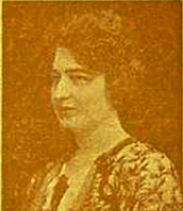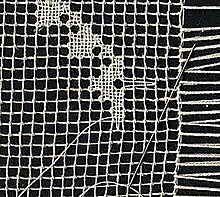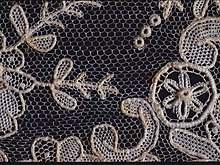| Adelaida Ferré Gomis | |
|---|---|
 (192?) (192?) | |
| Born | 24 February 1881 Barcelona, Spain |
| Died | 9 March 1955 (1955-03-10) (aged 74) Barcelona |
| Alma mater | Municipal Conservatory of Barcelona |
| Known for | historian, teacher, and folklorist associated with lace-making in Catalonia |
Adelaida Ferré i Gomis de Ruíz de Narváez (Barcelona, 24 February 1881 - Barcelona, 9 March 1955) was a Spanish historian, teacher, and folklorist associated with lace-making in Catalonia.
Early life and education
Adelaida Ferré Gomis was the daughter of the painter and decorator Pere Ferré. Her education began at the Escola Normal Superior de Mestres before attending the Municipal Conservatory of Barcelona and the Escola d'Institutrius. There, she had as a teacher the folklorist es:Rossend Serra i Pagès.
Between the years 1902 and 1915, she received artistic training at the Escola de la Llotja. She combined her artistic studies with those at the ca:Institut Català de les Arts del Llibre and the es:Centro de Cultura de Mujeres Francesca Bonnemaison, where she was able to perfect her knowledge of lace-making and other crafts. One of Adelaide's teachers at this institute was es:José Fiter e Inglés, who awakened Ferré's interest in the history of needle lace.
Career



During these years, her works were also exhibited in important exhibitions, such as the Exposición de retratos y dibujos antiguos y modernos that took place in 1910 at the Palau de les Belles Arts, organized by the Barcelona City Council. She also participated in the Exposició d'Art de Barcelona in 1920 and in the Exposició de ferros artístics organized by the Guild of Locksmiths and Ferrers and the Commonwealth of Catalonia at the es:Galerías Layetanas the following year.

Ferré focused both the practice of labor and the plastic arts in teaching. She taught artistic drawing and engraving at the Municipal School of Arts in the eighth district of Barcelona; modeling and engraving at the Municipal School for the blind, mute and other disabled; art history at the Women's Professional School of the Provincial Government of Barcelona; and embossed leather classes at the Saint George's School for Ladies in Barcelona and at Acción Femenina. But where Ferré spent a large part of her professional life was at the Municipal School of Trades for Women, later refounded under the name of Lluïsa Cura [ca] School (now Institut Lluïsa Cura). There, she taught embroidered lace and needle lace since 1911. She was appointed director in 1942 and retired after ten years.
Ferré's pedagogic spirit, influenced by Serra i Pagès, is clearly evident in the research she carried out on any aspect related to textile activities considered feminine, especially everything that refers to lace. Always interested in dissemination, Ferré not only practiced it through teaching in the classrooms but also in numerous conferences and in the preparation of articles.
Ferré is the historian of lace in Spain. Apart from the rigor and seriousness of her work, its relevance lies in the fact that, at the time she began to theorize about this art, the respective bibliography produced in Catalonia was very scarce. In the first stage, her studies appeared in publications such as Joventut, Art jove, and La Veu de Catalunya, among others. Between the years 1931 and 1948, Ferré's main studies appeared in the Butlletí del Museu d'Art de Barcelona, an institution in which she collaborated by documenting its textile collection.
From Ferré's research, a large amount of data of great value and usefulness can be obtained when tracing a history of textile production both within and outside Catalonia. She also documented and cataloged the collections of the Barcelona art museums directed by es:Joaquim Folch i Torres. Regarding bobbin lace, Ferré showed herself in her articles as a great connoisseur of its past, but also of its present, in Catalonia and in the rest of Europe. Techniques, folklore, history or lexicon of bobbin lace, Ferré treated and studied all these aspects in depth.
Like Joan Amades and other prominent folklorists, Ferré was also interested in the international language Esperanto and in 1909, she participated in the fifth international congress of this language, held in Barcelona.
Legacy
In the present day, Ferré is remembered for having been, in a certain way and together with Francesca Bonnemaison, the origin of the ca:Escola de Puntaires de Barcelona. It was Ferré who commissioned the sisters Antònia and Montserrat Raventós Ventura [ca] to give lace classes at the Lluïsa Cura School, of which Ferré was the director. Ferré also had a close relationship with the es:Fomento de las Artes y del Diseño and the Centre Excursionista de Catalunya. Her publications are held by the Fishing Museum of Palamós and the Library of Catalonia. The Marès Lace Museum hold two samples of bobbin lace designed by Ferré and made by ca:Clotilde Pascual i Fibla which were displayed in the 1918 exhibition in Barcelona at the Palau de les Belles Arts organized by the Fomento de las Artes y del Diseño.
References
- ^ "Diccionari Biogràfic de Dones - Biografia 4069". dbd.vives.org (in Catalan). Retrieved 5 February 2023.
- Ferré i Gomis, Adelaida. De folklore. Ilustració Catalana (192?). OCLC 807302221.
- Exposición de retratos y dibujos antiguos y modernos: catálogo ilustrado (in Catalan). Barcelona: Ajuntament de Barcelona. Imprenta de Henrich y Cia. 1910. p. 114.
- Fontbona, Francesc (2002). Montmany, Antònia; Coso, Teresa (eds.). Repertori de catàlegs d'exposicions collectives d'art a Catalunya (fins a l'any 1938) (in Catalan). Institut d'Estudis Catalans. pp. 91, 120, 124. ISBN 9788472836617. OCLC 470763819.
- Villena, Isabel Rodrigo (2017). "Las artistas catalanas, su lugar en la revista "Feminal" (1907-1917)". Locus Amoenus (in Spanish) (15): 223–244. doi:10.5565/rev/locus.299. ISSN 1135-9722. Retrieved 6 February 2023.
- Villalba Arasa, Laura, Adelaida Ferré i Gomis, folklorista. Edició, catalogació i estudi del seu corpus rondallístic (doctoral thesis), pp. 132-33. (in Catalan)
Further reading
- Villalba Arasa, Laura (2019). Adelaida Ferré i Gomis, folklorista: l'art de brodar rondalles (in Catalan). Publicacions de l'Abadia de Montserrat, S.A. ISBN 978-8491910497.
[
Categories: